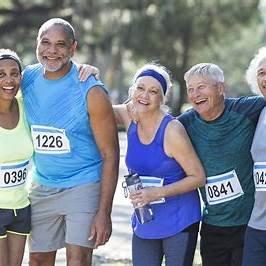6
Section One: The Fundamentals
A) Keywords
Exercise 1:
Provide a brief definition of one of the padlet keywords for this week.
| Aging habitus refers to the way social and cultural factors shape how people experience and embody aging. It’s all about the unconscious habits, attitudes, and behaviours we pick up from our environment. When referring to aging, it means that how we grow older isn’t just about biology, It’s also about the social norms, expectations, and personal experiences that influence how we see ourselves and act as we age. |
B) The Social Significance of Aging in Sport
Exercise 2: Notebook Prompt
How is old age popularly represented today? Find an image online that you think exemplifies one defining attitude towards old age and paste in your notebook below with a brief explanation of what this image means to you.

|
Exercise 3: Notebook Prompt
What does the article (referencing another study by Dionigi) mean by its statement that sport can help aging people to simultaneously “accept and resist the ageing process” (572)? Respond by audio or text and find paste two images sourced online into your notebook showing how sport might help aging people to both accept and resist the aging process.
| Playing sports as you get older is a way to both roll with the punches of aging and push back against it at the same time. On one hand, staying active helps older adults recognize and adapt to the natural physical changes that come with age, like slower reflexes or less endurance, without seeing them as limitations. But at the same time, sports allow them to challenge the idea that aging means becoming weak or inactive. Whether it’s a 70-year-old running marathons or a senior lifting weights alongside their grandkids, these activities prove that aging doesn’t have to mean sitting on the sidelines. Instead, it’s about finding new ways to stay strong, capable, and engaged in life
.
|
Exercise 4: Notebook Prompt
Who are the groups less likely to have extensive opportunities to take part in sports, according to Pike? How does privilege factor into aging and sport? (200 words max)
|
According to Pike, groups less likely to have extensive opportunities to participate in sports include people with disabilities, those who are very frail, minority ethnic groups, individuals living in rural areas, and those in care facilities. Women, especially older women, also face barriers due to societal expectations around caregiving roles. These groups often lack access to proper facilities, resources, or encouragement to stay active. Privilege plays a huge role in aging and sports because those with more economic and cultural capital have way more opportunities to stay involved in physical activity. Wealthier individuals can afford gym memberships, personal trainers, or specialized equipment, while lower-income individuals may not have the same access. There’s also a social privilege tied to how aging is perceived, older athletes who fit into the “successful aging” category are celebrated, while those who don’t meet these standards may be overlooked or even judged for not staying active. The ability to take part in sports is shaped by class, race, gender, and overall access to resources. |
Exercise 5: Padlet Discussion
Why do you think age discrimination is “reported more than any form of prejudice” with older people presented as a threat to social values and interests? Feel welcome to use video in your responses. Paste your comments (or transcript of your video) below!
| Age discrimination is so common because aging is something everyone eventually experiences, but society tends to glorify youth and productivity. Older people are often seen as a burden rather than a valuable part of the community, especially in cultures that prioritize economic output and innovation. Since aging is associated with physical decline and dependence, older adults can be marginalized or even seen as obstacles to progress. There’s also a deep fear of aging itself, people don’t want to be reminded of their own mortality, so they distance themselves from older individuals. This makes ageism unique compared to other forms of discrimination, because it’s rooted not just in prejudice but also in a widespread cultural anxiety about growing old. |
B) Older Women and Sport
Exercise 6: Notebook Prompt
What differences do you see in these ads? Which one is more inclusive? How is age represented or not represented in each? Answer these questions in your notebook.
| The Nike: You Can’t Stop Us ad is more inclusive because it features a diverse range of athletes across different sports, genders, abilities, and ethnicities. It highlights people of all ages, including older athletes, showing that sport is for everyone. There is no clear divide between men and women and there was no point in the ad where I thought “that was a bit sexist”. In contrast, the This Girl Can: Me Again ad focuses more on everyday women getting back into fitness, but it primarily represents women who struggle being active. There are random shots that make no sense in empowering women to be active. A tampon hanging out of underwear has nothing to do with sports and was honestly shocking. The women were lifting small weights, running and swimming. These are considered “easy” activities in comparison with with other ad, which showcased actual skilled sports. Both ads challenge traditional ideas about who belongs in sports, Nike’s ad does a better job of including all people in all sport, where the This Girl Can ad was quite frankly a bit misogynistic. |
Exercise 7: Notebook Prompt
In her article, “Assessing the sociology of sport: On age and ability,” Elizabeth Pike references a “trend towards a ‘feminisation of ageing’, with many women living longer than men” (573). Do you agree that aging has been “feminized” in this way? How? Answer these questions in your notebook.
|
|
Section Three: Module Mini Assignment
|
The controversy surrounding the proposed pickleball courts at Bonnerworth Park reveals much about how we view aging, sport, and public space. A $4.4 million plan aims to replace existing green spaces, baseball diamonds, and tennis courts with 16 pickleball courts and expanded parking, sparking concerns from local residents about noise, the lack of community consultation, and potential environmental impacts. While city officials argue that the project promotes active living, critics are questioning whether it’s fair to prioritize one sport at the expense of versatile public spaces that can serve a broader range of activities. The way this issue has been framed in the media and on social platforms showed age-related biases. Older pickleball players are often portrayed as being out of touch or overly demanding, even though they’re simply advocating for a space to engage in a sport they love. This reflects an ageist view that sees older adults, especially those advocating for recreational spaces, as obstacles rather than valued members of the community. The Pike article highlights how older populations are often sidelined in sport, and the negative portrayal of pickleball enthusiasts as a disruption reinforces harmful stereotypes that paint older adults as burdens rather than active, contributing citizens. The conversation also touches on the broader, neoliberal notion of aging. We often hear that older adults should “age successfully” by staying physically active, but this narrative overlooks the reality that access to such opportunities is not equal for everyone. Wealthier, healthier seniors may easily benefit from projects like these, while those with mobility issues or lower-income backgrounds might face barriers to participating in sports. This case underscores the complexities of aging and sport in public life. While promoting physical activity in later years is a positive thing, it also brought to light questions about inclusivity, environmental impact, and how society views older populations. The pickleball debate was shocking considering the amount of popularity it has gained in the media, especially among teenagers.
|



